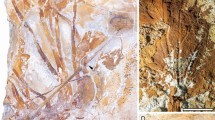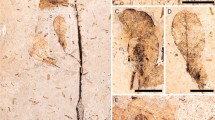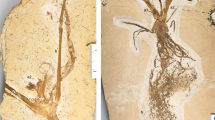Abstract
Today the asterids comprise over 80,000 species of flowering plants; however, relatively little is known about the timing of their early diversification. This is particularly true for the diverse lamiid clade, which comprises half of asterid diversity. Here, a lamiid fossil fruit assigned to Icacinaceae from the Campanian of western North America provides important macrofossil evidence indicating that lamiids diverged at least 80 million years ago and sheds light on potential Cretaceous rainforest-like ecosystems.
This is a preview of subscription content, access via your institution
Access options
Access Nature and 54 other Nature Portfolio journals
Get Nature+, our best-value online-access subscription
$29.99 / 30 days
cancel any time
Subscribe to this journal
Receive 12 digital issues and online access to articles
$119.00 per year
only $9.92 per issue
Buy this article
- Purchase on Springer Link
- Instant access to full article PDF
Prices may be subject to local taxes which are calculated during checkout

Similar content being viewed by others
Data availability
Data sharing is not applicable to this article as no datasets were generated or analysed during the current study.
References
Magallón, S., Gómez-Acevedo, S., Sánchez-Reyes, L. L. & Hernández-Hernández, T. A metacalibrated time-tree documents the early rise of flowering plant phylogenetic diversity. N. Phytol. 207, 437–453 (2015).
Atkinson, B. A., Stockey, R. A. & Rothwell, G. W. Tracking the initial diversification of Asterids: anatomically preserved Cornalean fruits from the Early Coniacian (Late Cretaceous) of Western North America. Int. J. Plant Sci. 179, 21–35 (2018).
Manchester, S. R., Grímsson, F. & Zetter, R. Assessing the fossil record of asterids in the context of our current phylogenetic framework. Ann. Mo. Botanical Gard. 100, 329–363 (2015).
Martínez, C. et al. Rariglanda jerseyensis, a new ericalean fossil flower from the Late Cretaceous of New Jersey. Botany 94, 747–758 (2016).
Stull, G. W., Soltis, P. S., Soltis, D. E., Gitzendanner, M. A. & Smith, S. A. Nuclear phylogenomic analyses of asterids conflict with plastome trees and support novel relationships among major lineages. Am. J. Bot. 107, 790–805 (2020).
Zhang, C. et al. Asterid phylogenomics/phylotranscriptomics uncover morphological evolutionary histories and support phylogenetic placement for numerous whole-genome duplications. Mol. Biol. Evolution 37, 3188–3210 (2020).
Magallón, S., Crane, P. R. & Herendeen, P. S. Phylogenetic pattern, diversity, and diversification of eudicots. Ann. Mo. Botanical Gard. 86, 297–372 (1999).
Angiosperm Phylogeny Group. An update of the Angiosperm Phylogeny Group classification for the orders and families of flowering plants: APG IV. Bot. J. Linn. Soc. 181, 1–20 (2016).
Manchester, S. R. & O’Leary, E. L. Phylogenetic distribution and identification of fin-winged fruits. Bot. Rev. 76, 1–82 (2010).
Hilton, R. & Antuzzi, P. Chico Formation yields clues to Late Cretaceous paleoenvironment in California. Calif. Geol. 54, 4–10 (1997).
Ward, P. D., Haggart, J. W., Mitchell, R., Kirschvink, J. L. & Tobin, T. Integration of macrofossil biostratigraphy and magnetostratigraphy for the Pacific Coast Upper Cretaceous (Campanian-Maastrichtian) of North America and implications for correlation with the Western Interior and Tethys. Geol. Soc. Am. Bull. 124, 957–974 (2012).
Verosub, K. L., Haggart, J. W. & Ward, P. D. Magnetostratigraphy of Upper Cretaceous strata of the Sacramento Valley, California. Geol. Soc. Am. Bull. 101, 521–533 (1989).
Parham, J. F. & Stidham, T. A. Late Cretaceous sea turtles from the Chico Formation of California. PaleoBios 19, 1–7 (1999).
Stull, G. W., Duno de Stefano, R., Soltis, D. E. & Soltis, P. S. Resolving basal lamiid phylogeny and the circumscription of Icacinaceae with a plastome‐scale data set. Am. J. Bot. 102, 1794–1813 (2015).
Miers, J. Observations on the affinities of the Olacaceæ. Ann. Mag. Nat. Hist. 8, 161–184 (1851).
Reid, E. M. & Chandler, M. E. J. The London Clay Flora (Oxford Univ. Press, 1933).
Stull, G. W., Herrera, F., Manchester, S. R., Jaramillo, C. & Tiffney, B. H. Fruits of an “Old World” tribe (Phytocreneae; Icacinaceae) from the Paleogene of North and South America. Syst. Bot. 37, 784–794 (2012).
Rankin, B. D., Stockey, R. A. & Beard, G. Fruits of Icacinaceae from the Eocene Appian Way locality of Vancouver Island, British Columbia. Int. J. Plant Sci. 169, 305–314 (2008).
Rio, C. D., Thomas, R. & Franceschi, D. D. Fruits of Icacinaceae Miers from the Palaeocene of the Paris Basin (Oise, France). Earth Environ. Sci. Trans. R. Soc. Edinb. 108, 459–469 (2017).
Stull, G. W., Adams, N. F., Manchester, S. R., Sykes, D. & Collinson, M. E. Revision of Icacinaceae from the Early Eocene London Clay flora based on X-ray micro-CT. Botany 94, 713–745 (2016).
Scott, R. A. & Barghoorn, E. S. Phytocrene microcarpa – a new species of Icacinaceae based on Cretaceous fruits from Kreischerville, New York. J. Palaeosciences 6, 25–28 (1957).
Knobloch, E. & Mai, D. H. Monographie der früchte und samen in der Kreide von Mitteleuropa. Rozpravy ústredího ústavu geologickénho Praha 47, 1–219 (1986).
Soudry, D. & Gregor, H.-J. Jodes israelii sp. nov.: a huge phosphate-mineralized icacinacean fructification from the Late Cretaceous of the Negev, southern Israel. Cretac. Res. 18, 161–178 (1997).
Stull, G. W., Moore, B. R. & Manchester, S. R. Fruits of Icacinaceae from the Eocene of southeastern North America and their biogeographic implications. Int. J. Plant Sci. 172, 935–947 (2011).
Del Rio, C. & De Franceschi, D. Fossil record of the Icacinaceae and its paleogeographic implications. Rev. Palaeobot. Palynol. 273, 104135 (2020).
Tang, K. K., Smith, S. Y. & Atkinson, B. A. Extending beyond Gondwana: Cretaceous Cunoniaceae from western North America. N. Phytol. 234, 704–718 (2022).
Atkinson, B. A., Stockey, R. A. & Rothwell, G. W. Cretaceous origin of dogwoods: an anatomically preserved Cornus (Cornaceae) fruit from the Campanian of Vancouver Island. PeerJ 4, e2808 (2016).
Atkinson, B. A. Fossil evidence for a Cretaceous rise of the mahogany family. Am. J. Bot. 107, 139–147 (2020).
Matsunaga, K. K. S. & Smith, S. Y. Fossil palm reading: using fruits to reveal the deep roots of palm diversity. Am. J. Bot. 108, 472–494 (2021).
Atkinson, B. A. The critical role of fossils in inferring deep‐node phylogenetic relationships and macroevolutionary patterns in Cornales. Am. J. Bot. 105, 1401–1411 (2018).
Srivastava, R., Wheeler, E. A., Manchester, S. R. & Baas, P. Wood of Oleaceae from the latest Cretaceous of India – the earliest olive branch. IAWA J. 36, 443–451 (2015).
Burnham, R. An overview of the fossil record of climbers: bejucos, sogas, trepadoras, lianas, cipós, and vines. Rev. Brasileira De. Paleontologia 12, 149–160 (2009).
Smith, S. Y., Little, S. A., Cooper, R. L., Burnham, R. J. & Stockey, R. A. A Ranunculalean Liana stem from the Cretaceous of British Columbia, Canada: Atli morinii gen. et sp. nov. Int. J. Plant Sci. 174, 818–831 (2013).
Acknowledgements
The author is grateful to D. Hilton (Sierra College) and P. Antuzzi for recovering the fossil, R. Greve and G. Bromm (Sierra College) for facilitating access to the studied material, and R. Shapiro (California State University – Chico) for bringing the fossil material to my attention. Thanks to R. Serbet (University of Kansas) for helpful edits on the manuscript. This work was supported by a University of Kansas New Faculty Research Development fund awarded to B.A.A.
Author information
Authors and Affiliations
Contributions
The author confirms sole responsibility for all aspects of this study including conception and design, fossil identification, imaging, taxonomy, interpretation of results, and writing and editing the manuscript.
Corresponding author
Ethics declarations
Competing interests
The author declares no competing interests.
Peer review
Peer review information
Nature Plants thanks James Doyle and Gregory Stull for their contribution to the peer review of this work.
Additional information
Publisher’s note Springer Nature remains neutral with regard to jurisdictional claims in published maps and institutional affiliations.
Extended data
Extended Data Fig. 1 Palaeophytocrene chicoensis Atkinson sp. nov. Holotype T 32.
Region of rectangle in Fig. 1d showing a less magnified view of papillate area in Fig. 1e in which the inferred papillae (exemplars at arrows) have a size and rounded-shape distinct from the surrounding matrix. Note that this was the only tubercle where these structures are observed. Scale = 100 µm.
Supplementary information
Rights and permissions
Springer Nature or its licensor (e.g. a society or other partner) holds exclusive rights to this article under a publishing agreement with the author(s) or other rightsholder(s); author self-archiving of the accepted manuscript version of this article is solely governed by the terms of such publishing agreement and applicable law.
About this article
Cite this article
Atkinson, B.A. Icacinaceae fossil provides evidence for a Cretaceous origin of the lamiids. Nat. Plants 8, 1374–1377 (2022). https://doi.org/10.1038/s41477-022-01275-y
Received:
Accepted:
Published:
Issue Date:
DOI: https://doi.org/10.1038/s41477-022-01275-y



